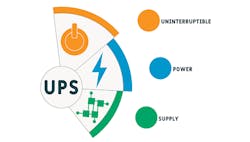An uninterruptible power supply (UPS) is a device that sits on a power grid—it could be just utility outlet in an office or as part of a control system—and transforms that power into stored energy.
Internal circuitry detects the loss of incoming power and automatically switches output power from the incoming circuit to the stored energy device. It is, in simple terms, a battery that is there just in case the electricity suddenly drops out.
I’m reminded of the little, but overly heavy, box that used to sit under my desk at one of my first jobs after graduating from college back in the mid-1980s. At that time, I was “the CAD guy,” and losing all the data in a CAD drawing was probably the worst possible thing that could happen to this guy who was fresh out of college and trying to eke out a living in this thrilling industry.
Not too long after that, I learned that an equal or perhaps worse thing that could happen was using the old T3 terminal from Allen-Bradley for programming a PLC-2 or -3 and losing power when you forgot to hit the save button.
Tied for “worst situation ever” was using a programming software from the 1990s and hitting the ESC button one too many times. Apparently, the designers of that original development software didn’t consider that someone might accidentally back out of the programming menu structure one too many times, with that same ESC button for each step, and find themselves out of the software and staring at the startup screen.
While not power-related, the prospect of losing hours of development when the power suddenly drops out was and is a fearful prospect.
As a little side note, my employer was so perplexed by this clear oversight in the original software that we took it upon ourselves to make our own programming software.
We hired a young man, still going to classes at the local university, to duplicate a much-loved programming software using Visual Basic, while we took on the somewhat daunting task of deconstructing the bits and bytes from a serial-port download to the processor using the original software into the mnemonic code that was the user interface in the programming software.
Empty program, download. XIC OTE, download. XIC, XIO OTE, download. Compare it. What is different? TON, download. Now, what changes?
As you can imagine, it took a few months of steady work, all while making CAD drawings, creating control systems, programming and commissioning that we were being paid to do by the customers. We attempted to work with the OEM on this software, but we were basically laughed out of the building.
After much work, we had a finished product. The OEM didn’t want it, so we offered it for sale on our own. Soon after, the OEM bought the product from us, and we agreed not to try that again. For those who use that hardware today, you wouldn’t know that there was a time where the ESC key could cause so much pain and suffering.
Back to the subject at hand. The need for an uninterruptible power supply is clear. Our industry, most industries, rely on computers to execute the job at one point or another. Where would we be without computers? A programmable controller is, after all, a purpose-built version of a computer. If a computer loses power suddenly, then the work being worked is lost with it.
Computers these days are a fair bit more sophisticated than the versions that I first used back in the 1980s. Most software applications automatically create progression backups while the application is open and close to a finished version when the software is closed. Wouldn’t that have been great with that old programming software with the killer ESC key?
Still, to lose development is heart-wrenching at any point in the process. The introduction of the laptop—with a battery, no less—has lessened the impact for those who use that as their main tool but does nothing for the desktop and servers of a business network architecture.
The purpose of a UPS is to spend most of its life doing absolutely nothing but, when called upon, provide a means by which a computer or server can continue to operate when there is a sudden loss of power. When power loss happens, people or sometimes software begin the process of properly saving any open applications and safely shut down the computer or server.
Also read: Power supplies get out of the cabinet
UPS systems vary in their power-delivery duration, but, at some point, they will no longer be able to provide power to the system. The worst thing that can happen when a computer or network goes down, under a controlled situation, during a power failure is that the person or persons using that system will not have that tool at their disposal until the power is restored.
However, what if that computer is controlling a water-treatment plant or a nuclear facility or a batch-making process in your plant? What if the computer is, in fact, a programmable logic controller (PLC) or programmable automation controller (PAC)?
Once considered a luxury for high-end control systems, a UPS is an important device in a world where data collection and e-commerce is at the forefront of business activities.
OEMs of equipment know the peculiarities of their own power supply in the plant but don’t usually know the power situation at the client’s facility. Discussions with the client, prior to starting the control system design, can go a long way to mitigating the situations that might arise at the end of the journey to the customer.
My own plant, for example, is in a part of the country where weather is frequently a negative impact on our power source. We can get bad storms in both summer and winter. Brownouts were once common occasions, although the number has been reduced as the local power company has made a concerted effort to cut back tree limbs from power lines to prevent contact during these storms.
Even a short power blip can send our system into version of cardiac arrest. Sometimes a single leg will drop out, or we can have a power drop and reconnect within seconds. Both of these scenarios can wreak havoc on our packaging equipment and control systems.
Product tracking and traceability is a very serious part of many industries, including pharmaceutical, food processing and logistics. For example, imagine UPS—the package forwarding company, United Parcel Service, in this case—if its distribution center suddenly lost power with thousands of packages somewhere along the conveying system on the way to a truck.
Drug-processing facilities produce hundreds or thousands of packages per minute. Product tracing is a life-or-death matter, and the ability to keep track of every single package at every step in the trip from the packaging machine to the consumer is essential and mandated by law.
Without a reliable power source for when the plant power stops, all the packages in the system would have to be destroyed out of an abundant use of caution.
Food-processing plants, especially for meats and vegetables, but really for all ingredients that are consumable, need a means by which to progressively shut down a line in a controlled manner. Packages that can be closed should be. Without the use of a UPS, this is practically impossible.
Incorporation of a UPS in a control design depends on the scale of the need to maintain power to the processor and the duration under which it must maintain a suitable supply.
Form factor—the size of the device—is also an important consideration. Control panels can grow exponentially if the need for a long-term source of power, independent from the main power source, is required for a process. Most major hardware manufacturers have a complete line of uninterruptible power supplies to suit most applications.
It is important to discuss the intended use of these devices to make sure that the solution will meet the need when an emergency occurs. You will want to make sure that you can get your process completely shut down before the backup supply of power is exhausted. Batteries, after all, don’t last forever.
Remember that today’s UPS isn’t that clunky box underneath your desk anymore. Many are not much bigger than the 24 Vdc power supply in your control panel. The price of a UPS is significantly less that it was even five years ago. Adding one to the design of your control system may be one of the best decisions you make. Focus on the need to safely stop your machine or process and get all the important data stored in a manner that allows you to correctly retrieve it when the normal source of power is restored. Can your UPS deliver?
Rick Rice is a controls engineer at Crest Foods, a dry-foods manufacturing and packaging company in Ashton, Illinois. With more than 30 years’ experience in the field of automation, Rice has designed and programmed everything from automotive assembly, robots, palletizing and depalletizing equipment, conveyors and forming machines for the plastics industry but most of his career has focused on OEM in the packaging machinery industry with a focus on R&D for custom applications. Contact him at [email protected].
About the Author
Rick Rice
Contributing Editor
Rick Rice is a controls engineer at Trew Automation, a material handling manufacturer based in West Chester, Ohio. With over 38 years’ experience in the field of automation, Rice has designed and programmed everything from automotive assembly, robots, palletizing and depalletizing equipment, conveyors and forming machines for the plastics industry but most of his career has focused on OEM in the packaging machinery industry with a focus on R&D for custom applications.

Leaders relevant to this article:


